What Martial Arts Do Most Law Enforcement Officers Learn

Law enforcement officers (including police officers, sheriffs, country troopers, corrections officers, deputies and more) have an incredibly difficult job.
Function of that job is the possibility of physical confrontations with aggressive individuals or groups.
Very broadly physical confrontations can be divided into two categories…
- Decision-making someone who doesn't want he or she is being instructed to do, or
- Defending yourself against someone who is actively attacking you lot.
Each of these categories contains within it a spectrum of possibilities.
For example, someone who is resisting you might but need some easily-on guidance in society to be convinced to walk over to a patrol vehicle, or might be flailing wildly to avoid being taken downward to the footing and handcuffed. Or someone who is attacking you might just give you lot a shove, or might be trying to gouge your optics out of your head or bite your nose off.
And of grade resistance can escalate into attack within seconds as a switch flips and seemingly normal people plough super-aggressive and even violent.
Somehow, fifty-fifty with all that doubt, constabulary enforcement personnel even so have to restraining ambitious people while trying to stay equally safety as they tin.
Unfortunately virtually agencies don't accept unlimited fourth dimension and budget to provide their officers with the training they may need to exercise their task safely and effectively. Additionally many of the techniques taught to control, detain and abort an aggressively resisting opponent just don't work in the real globe with loftier levels of adrenaline and a size discrepancy.
This article will share some of the bug with the well-nigh commonly taught arresting and decision-making protocols, and then movement into some proven defense and control methods that accept been proven in numerous combat sports (modified for the street environment of course).
The Problem with Most Police Enforcement Control Techniques
Somebody has to come up out and say it…
Many of the usually taught restraint techniques taught to police enforcement personnel are crap. At least they almost never work if the person using them doesn't have a large size and strength reward.
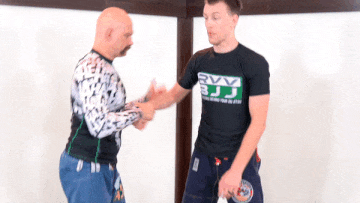
Hither's a video I shot with Rory Van Vliet breaking down exactly what'south wrong with the typical law enforcement defensive tactics and command techniques.
Rory is a corrections officer who has also spent a ton of time billowy in bars and doing security work. And he'south also a BJJ back belt so you know that he's pressure tested everything that he's talking about!
Now it's true that if someone is passively resisting and just needs a niggling nudge in the right direction that you might be able to control them with the standard wristlock control, especially if yous're larger and stronger than they are.
But this changes equally soon as they're adrenalised and in full fight or flying mode.
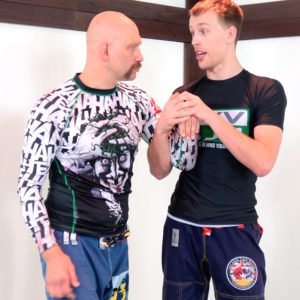
Techniques that DON'T piece of work reliably against adrenalised active resistance include the armbar takedown, wristlock controls, and pain compliance manoeuvres that come from traditional martial arts and have been imported into police enforcement.
Although they may feel effective against a compliant training partner, in real life they're not reliable for a number of reasons…
- The technique uses hurting compliance, which is very unreliable against a highly adrenalised opponent.
- The motility requires perfect fine motor skills (which go to hell in the chaos of a real confrontation)
- The technique is and so biomechanically deficient that it requires you to be much larger or stronger than your opponent
- The restraint leaves you in terrible position to defend confronting strikes if information technology fails
- And more than…
That leaves you with a motility that probably won't work against a tough guy, a situation where the officeholder can get severely injured if the perpetrator spins out and decks him, and a hard faceplant to the pavement (and accompanying lawsuit) if past some fluke the technique works as advertised.
My friend Rory Van Vliet is a corrections officer who has also worked as a bouncer, loss prevention agent, and security guard. Then he has confronted a lot of bad guys.
He's also a black chugalug in Brazilian jiu-jitsu with a potent background in other martial arts like Muay Thai and traditional jujutsu systems.
When we released the video called Police Enforcement & Security Techniques That Only Don't Work nosotros upset a lot of people because we show the exact techniques taught at police academies and security baby-sit preparation courses around the world and break down why they neglect against a resisting opponent.
There accept been two basic categories of response to our statements…
First at that place have been a lot of police officers, jail guards and security professionals who've basically said, 'Thanks for putting this out. I've had doubts almost this textile for years and I'm non in a position to change how things piece of work in my home department.'
But there take also been indignant martial artists protesting that, 'I've been pedagogy this material for 30 years and it can't be wrong.'
(Sadly just because something has been taught for years doesn't make it right. Intelligent people no longer retrieve the globe is flat, and doctors no longer use leeches to treat fevers.)
Anyway, if y'all practice nothing else after reading this please brand sure you sentry the video at the top of this article (here's a link to the video on Youtube) and laissez passer information technology on to someone who might need that info likewise.
At present that we've covered what you lot shouldn't do permit'south take a look at some solutions that actually work confronting a bigger, stronger, motivated opponent…
Using the Arm Drag to Become Behind Someone in a Confrontation
1 of the easiest, almost efficient ways to get to someone's back, standing or on the footing, is a move called the arm elevate.
The armdrag is literally used at the highest levels of BJJ and wrestling competition, and even occasionally shows up in MMA. If a motion has been pressure tested by the best grapplers in the world fourth dimension after time then you can have some existent confidence in it (as opposed to what some combatives instructor is telling you who might only have ever been in a shoving match or two).
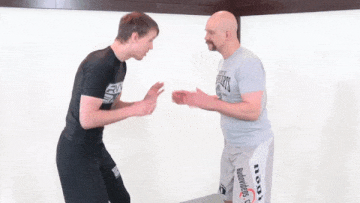
The best role is that the armdrag, dissimilar complicated throws and takedowns, requires relatively little strength and athleticism, at least if y'all pay attention to a couple of basic points.
In this video BJJ black belt Rory Van Vliet shows us exactly how he's used the armdrag in a prison setting, doing security piece of work, and bouncing at bars.
Now this isn't a movement you're going to apply if punches take started flying. Nether these circumstances the armdrag is still possible but a lot harder to pull off – you accept to preceed information technology with a clinching setup showtime.
The typical time to employ it is during the initial stages of a confrontation – the other guy is agitated, has his hands up. and you've decided that you lot're going to command him before things deteriorate any further.
The steps are broken down in the video above, but for quick reference here they are in written class too…
- Grip the back of his right manus from the outside with your left mitt to slightly curve his wrist – this makes it harder for him to take hold of y'all)
- Circle his right manus down (clockwise) and button information technology into his hip – this flares his elbow out and gives you access to his inside space
- Attain your right arm through his elbow and grip the back of his triceps with a monkey grip (no thumb)
- Pull his arm across your centerline and step in deep betwixt his legs (or straight behind him) with your correct leg
- Once his arm crosses your centerline go effectually his back and catch his far hipbone with your left hand
- Accept your chest tight to him to eliminate space and brainstorm to establish rotational control
- Control him with the seatbelt or rear bearhug grip (which nosotros'll cover in the next video and email)
This is a super-versatile move. You can use variations of it from the ii on one grip, the handshake grip, or even confronting someone crossing their arms and puffing out their chest.
Anyhow, the armdrag is a movement that anybody, everyone, everyone should have in their repertoire, regardless of whether they're wearing a bluecoat, competing in jiu-jitsu, or but interested in getting an border in a self defense situation.
How to Safely Command Someone from the Back
Not every confrontation is an all out MMA-style brawl.
Police enforcement officers and bouncers accept to move resisting people all the time while trying to keep both themselves and the perpetrator safe. And it'southward easy to imagine situations where civilians might demand to do this too (for example if Uncle Fred gets drunk and aggressive at the family BBQ. Again!).
Let'southward assume that you lot've got to go along someone under control and escort them somewhere. Furthermore let'southward assume that y'all want to stay on your feet – perhaps at that place are besides many other people effectually to take things to the ground for instance.
Here's a video showing you exactly how to control and movement an ambitious person while keeping yourself as condom (and lawsuit free) as possible…
We'll wait at the specific techniques in a second but there are a couple of super of import concepts to sympathize first…
Rotational Control
This is a concept that shows upward all the time in Brazilian jiu-jitsu, but it applies both standing and on the basis.
Essentially you want to use your grips to mucilage yourself to his back and then that you're always backside him where he has the least chance of hurting y'all (all of his natural weapons are facing forwards at this point).

If he turns and so you plough with him, or – if y'all're strong plenty – you can maybe prevent him from turning at all.
Breaking Alignment
Another of import concept is to continuously piece of work to break your opponent's alignment so that he tin't put himself into a position to strike effectively, get out of your grips, or turn and face you.
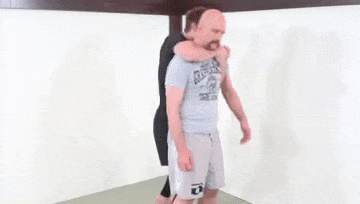
Alignment consists of iii things…
- Base – his connectedness with the ground allowing him to generate force and resist strength
- Posture – the right alignment of his spine, from his neck down to his lower back
- Structure – the correct positioning of his limbs and then that he tin can use them effectively
(If you're interested in going deeper into this concept then here's a detailed breakdown of base of operations, posture and structure in the context of Brazilian Jiu-Jitsu. The examples are all from the basis but the concepts all employ equally to standing situations as well).
Bottomline: whenever you lot're trying to control someone you want to take away their alignment past continuously disrupting their base, posture and construction, no matter what method of actual method of control you're using.
Methods of Command
At that place are multiple ways to effectively control someone from behind, and you should be familiar with them all. No one method will piece of work for everyone, against every kind of opponent, under all circumstances. so it's important that you learn different ways to do it.
There are iii master methods and a couple of variations…
Control Method 1, Seatbelt Control
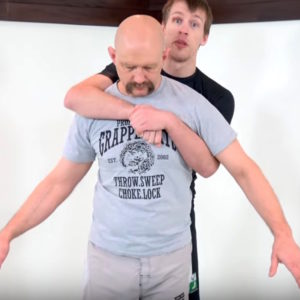
This is a archetype command method used extensively in Brazilian Jiu-Jitsu when establishing rearmount or attacking the turtle (download a PDF breaking down these positions for free here).
The seatbelt control in itself is NOT a choke, but BJJ practitioners adopt it because it allows them to easily transition into chokes, most oft the rear naked choke or the RNC.
Unlike the sport of BJJ moving directly into the choke isn't appropriate in every situation. Yous'll accept to judge the legality and optics of applying the choke for yourself, based on the situation and the rules governing how you tin escalate up the apply of force continuum.
The basic seatbelt control looks like this…
- I arm comes over his shoulder, your other arm comes through his armpit
- Connect hands in the middle of his chest
- Your top mitt makes a fist and your lesser hand grips the top hand to hide the summit manus (to preserve the pick of moving to a vascular neck restraint – a choke – if the situation warrants information technology)
- Your chest connects to his back
- Your head is tight to his trunk and your optics are looking down to protect from centre gouges and punches
Control Method 2, The Gable Grip
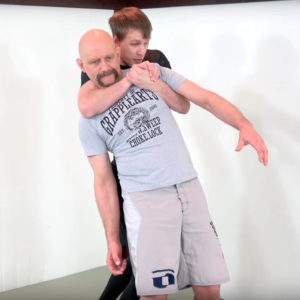
The Gable grip control is like to the seatbelt control, but increases your rotational control at the expense of making it more difficult to apply the choke if necessary.
In the Gable grip your meridian arm comes across your opponent'due south breast, which gives you lot some additional ability to manipulate the shoulders. But a canny opponent (and pretty muchanyonetrained in BJJ, Judo or MMA) will immediately take hold of that arm and pull it down.
Him pulling our arm down isn't a bad thing necessarily – he can't utilise them to grab a weapon and you lot now know exactly where they are – but if you open your grip to motion to the neck he could become complimentary of your command. It's a tradeoff that you lot'll have to make for yourself.
- One arm comes over his shoulder, your other arm comes through his armpit (equally with the Seatbelt Control)
- Dissimilar the Seatbelt Command your hands are off to the side using a palm to palm grip at one shoulder
- Your elbow is controlling the other shoulder allowing your the ability to rotate your opponent
- Your forearm comes across the forepart of his breast
Control Method 3, The Rear Trunk Lock
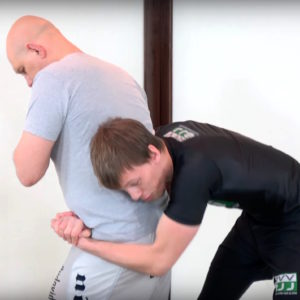
Both the seatbelt and the Gable grip require you to come over one shoulder.
If the person is also tall and you can't break them downwards backwards to your summit, then yous might be looking at using the rear body lock.
Y'all might exist concerned about getting elbowed in the face from this position but it's not that big a take a chance.
Starting time of all by closing the distance and taking away space he won't exist able to generate much force. He will besides typically exist hitting yous with his triceps, not the pointy part of his elbow, which further reduces the harm. And also you're non going to hang out here for very long – you'll be working actively to disrupt his alignment, move him around, and accept him down to the ground if required.
Cardinal points near the rear body lock include…
- Position yourself at 45 caste angle to his dorsum
- 1 arm goes in front end of his hips
- Your easily connect using an South grip, Gable grip, or even gripping your own elbows (to control someone very small)
- Your shoulder is in the small of the back pushing forward
- Your head is likewise against his dorsum, eyes facing down to take them out of the line of fire
Other Control Methods
The three methods of control covered higher up are effective but not exhaustive.
There are other options available to you every bit well, including a neck grip (not quite a choke simply withal, check with your use of forcefulness regulations) and an effectually the chest with a far lat grip control positions…
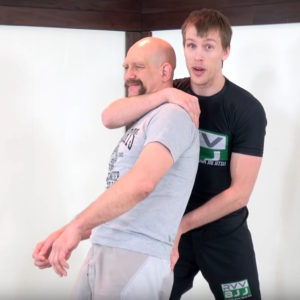

In both cases you lot desire to go on the guy off-balanced and amplify the alignment interruption by pushing his hips forward with your free arm.
How to Accept Someone Down When You Have Back Control
Despite the fact that Rory and I are both BJJ black belts, neither of the states advocates that every fight should be taken to the footing. Sometimes it'south much safer to stay on your anxiety, especially if in that location are a lot of people around.
Simply when yous really need to control someone dangerous, or put a resisting person into handcuffs, your best option but might be to have them to basis (click here for 5 Reasons to Grapple in a Streetfight).
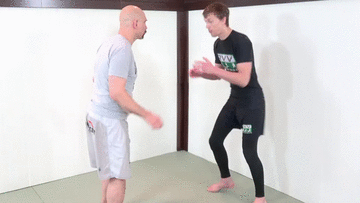
The trouble is that many takedowns from Judo, Sambo and Wrestling are highly technical, requiring thousands of repetitions to learn and then boosted training to proceed sharp.
And then you're not going to exist Judo-flipping anyone anytime presently. A person can easily die if his head smashes into the pavement at high speed which could hands happen if you hoist someone onto your shoulders and slam them into the ground. And even if they 'but' break an arm from the throw the resultant litigational nightmare might brand you wish you lot hadn't been quite and so dynamic in your takedown.
What we're looking for are relatively simple, relatively safe means to have a doubtable or resisting opponent to the footing, preferably ones that doesn't require a ton of grooming to learn and remember.
In the next video we'll show you 2 of the best options to practise simply that from the back position…
Takedown 1: Rear Bodylock Takedown
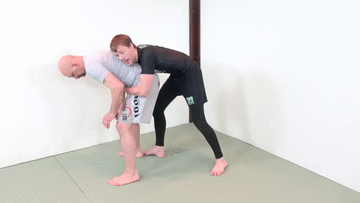
The basic takedown from the rear bodylock has been used and proven in a wide variety of combat sports. It is very similar to the Judo throw called 'Tani Otoshi' but variations of it exist in Sambo, Wrestling and MMA.
Basically you're dragging your opponent downward to the basis backwards while blocking his foot. If you spotter the video above you'll option upward a couple of cool pointers that aren't commonly taught which make the takedown even more effective.
Here are the steps…
- Start by controlling his hips with the rear body lock, ideally with one of his artillery trapped but that'southward not 100% neccesary
- If his legs are narrow then use the bodylock to milk shake him around until he plants his feet further autonomously
- Step one of your feet correct backside his same side human foot
- Bring your other pes backside his left heel to terminate him from stepping back
- Kick one leg directly like a baseball slide
- Loosen your bodylock control, fall dorsum, then pull him beside yous
- Tuck your elbow so that it doesn't hit the ground, instead whorl over your shoulder
- Come up to the top and command your opponent
Yous might have some legitimate concerns about dragging someone down on top of y'all, especially if you suffer from claustrophobia while grappling (click hither for Dealing with Claustrophobia in Grappling and BJJ).
In an platonic world you DON'T pull him on top of you; instead yous pull him to your side and come up on acme in what BJJ people call 'Side Command.'

Or, better nonetheless, progress from Side Command to an fifty-fifty more ascendant position like the Giftwrap.
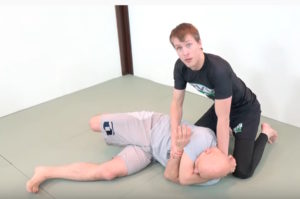
But if worst comes to worst and y'all pull him backwards on top of you the of import thing isnot to panic!
Just like on your feet, being backside your opponent on the ground is a very good identify to be then long equally you accept some basic jiu-jitsu. You're behind your opponent where it'due south harder for him to hurt you lot, you can use your legs to assistance control your opponent and and then transition to another position or peradventure escalate upwardly the strength continuum to utilise a choke.
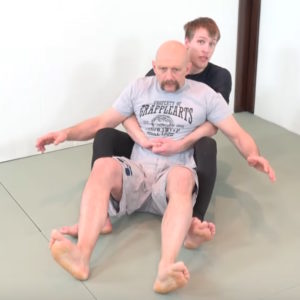
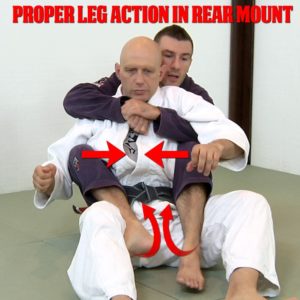
Takedown 2: Sitdown from the Seatbelt
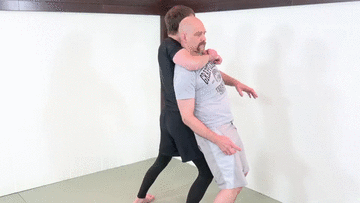
If you have seatbelt control (as opposed to the rear bodylock control) then your typical takedown is going to be a little unlike.
The goal here is to drive his shoulders backwards faster than his anxiety can compensate.
This is a very irksome, very controlled takedown that's safety for you AND your opponent – just because he's been an idiot at the bar doesn't hateful he deserves to have his confront smashed into the pavement.
Some of the key points are…
- Start in the seatbelt, your hands linked in the centre of his chest with one arm coming over his shoulder and the other through his armpit
- Drive your hips frontward and pull at his shoulders to curve him backwards
- Remove your hips from his, step back and drop downwards to ane knee, depositing him on his butt
- Proceed your seatbelt once he's sitting down – information technology puts you into a nifty bargaining position and may let y'all to talk some sense into the guy
How to Defend Confronting Punches with the Front Bodylock
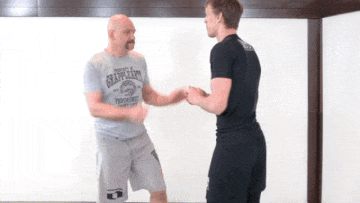
Neither Rory nor I are advocating that grappling is e'er the correct course of action. If you tin withdraw from a situation and use pepper spray, a taser, a handgun, or wait for backup then that's frequently what you should do.
However y'all DO need to take shut quarter solutions in your toolkit because at that place are many potential scenarios where information technology may not exist possible to undo from a trigger-happy attacker, depict a weapon, or look for backup. For example…
- Maybe you lot're a police officeholder interviewing a suspect who of a sudden decides to take a swing at you lot…
- Or peradventure y'all're a bouncer working in a crowded bar and a drunk starts flailing at you at close quarters…
- Or maybe you're working at a hospital dealing and don't have the option soak elderly dementia patients in capsicum spray.
So let'south give you an selection for protecting yourself against strikes and regaining control of a situation using the front end bodylock.
Hither's a video for when yous need to movement in and command your opponent….
Punch Defense Part one – Closing the Distance
The bones idea of defending confronting strikes is that youeitherwant to be too far away from your opponentortoo shut for them to hit you with much strength.
A punch is strongest when it'due south at full extension…
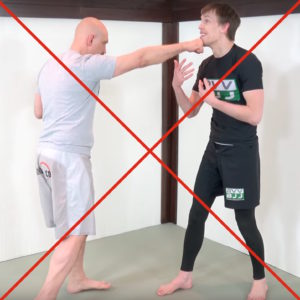
The logic of getting closer to a violent attacker comes downwardly to ane simple fact – information technology'due south a lot harder for someone to knock you out when you're really shut to them.
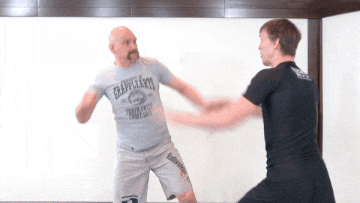
When you close the distance y'all desire to minimise the amount of time yous spend in the danger zone.
Your chances of getting hurt by a dial on the way in decrease significantly if you do these three things…
- Shut the altitude at with conviction and at maximum speed
- Slightly driblet your height as you close (known as 'level changing')
- Shield your caput by folding your your forearms effectually it (a position known every bit the 'helmet')
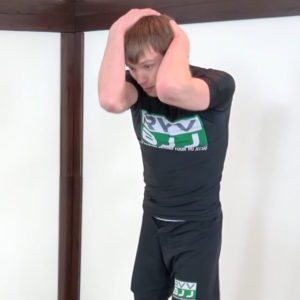
Punch Defense Part 2 – Establishing the Front Bodylock
Earlier in this commodity we made a strong example for you wanting to bebehind your opponent.
Sadly that'southward not ever possible, simply yous can yet establish a potent control over him from the front that withal breaks his alignment and minimises the amount of power he can put into any strike).
The primary goal here is to establish a control position known as the front bodylock…
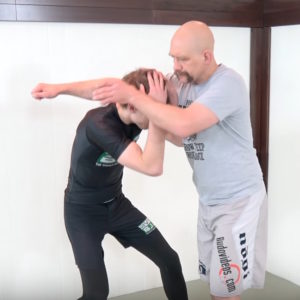
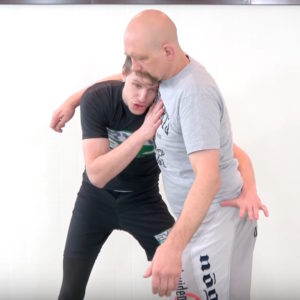
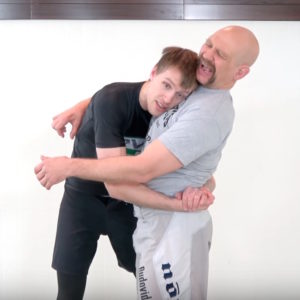
Here are some key points for the forepart bodylock…
- After you crash in don't stay right in front of your opponent; ideally try to go to 45 degrees off centerline.
- When your elbows make contact i arm goes around his low back
- Connect your hands, either in a Gable grip or a monkey grip
- Connect your head to his chest, top of your head under his jaw, so that he tin can't bite you lot
- Keep your legs wide for base of operations
- Pull his hips frontwards with your arms and bulldoze his upper body backwards using your shoulder and your caput
In the front bodylock you're relatively safe. It's very hard for him to punch or knee you with any power, your caput and neck are beneath the level of his teeth, and if he goes for a headlock or a guillotine asphyxiate he opens up a route to his dorsum and the rear bodylock.
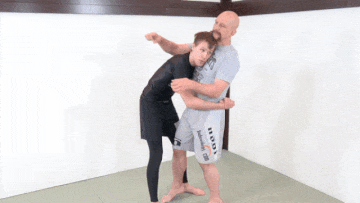
The front bodylock is definitely a position you should practice because it'southward very mutual to end up here instinctively if you get blitzed by an attacker.
Better to be comfortable hither and know how to use it to your reward than trying to figure information technology out for the offset fourth dimension when the pressure is on!
From hither peradventure y'all can just stall for a while and wait for a partner to jump in, or perhaps you lot need to have things to the ground to establish some control or handcuff the guy. We'll look at how to do that next…
Punch Defence force Part iii – The Folding Takedown
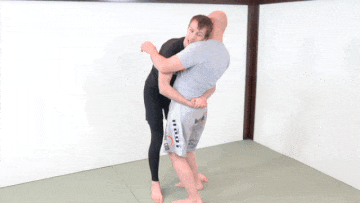
A simple way to take someone down from the forepart bodylock is with the folding takedown.
Basically you're going to go on on pulling his hips forwards and driving his upper body backwards until his base tin can no longer support him.
At that signal the only thing property him up is you, so let get of him and mail service your easily on the basis. Don't maintain the bodylock because you're actually stopping him from falling (and yous could injure your easily or arms if they're under his trunk when he falls).
As he falls move into a control position. Depending on the way he falls, how he reacts, and his level of grooming you may be able to move into the mount, side control, or a different command position.
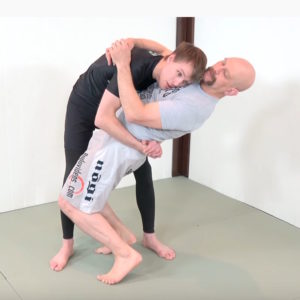
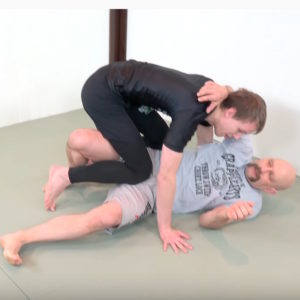
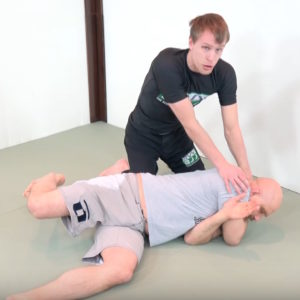
These videos and techniques are based on a ton of personal experience accumulated both in thousands of hours of training against resistance and as well existence in potentially unsafe situations in real life.
We hope you have enjoyed this textile and institute it useful,
Rory and Stephan
More than from Rory Van Vliet
Rory is a BJJ black belt with Island Pinnacle Squad. You tin click hither to check out his Youtube channel or click here to check out BJJConcepts.cyberspace which is a cutting edge instructional site he runs together with Rob Biernacki.
Rory and I have likewise worked together on a BJJ instructional called 'The Baby-sit Memory Formula.'
This a very detailed and comprehensive tutorial on how to make information technology much, much, much harder for your opponent to get past your legs when you're in a defensive position on the ground!
It's really good. Check out the trailer for this instructional below…
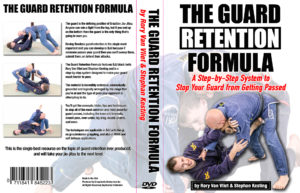
If you're not sick of me yet and so here are some of my social media links…
- Tiktok (NEW)
- Youtube
And, most importantly, proficient luck with your training!
Stephan
Source: https://selfdefensetutorials.com/control-techniques-for-law-enforcement/
0 Response to "What Martial Arts Do Most Law Enforcement Officers Learn"
Postar um comentário